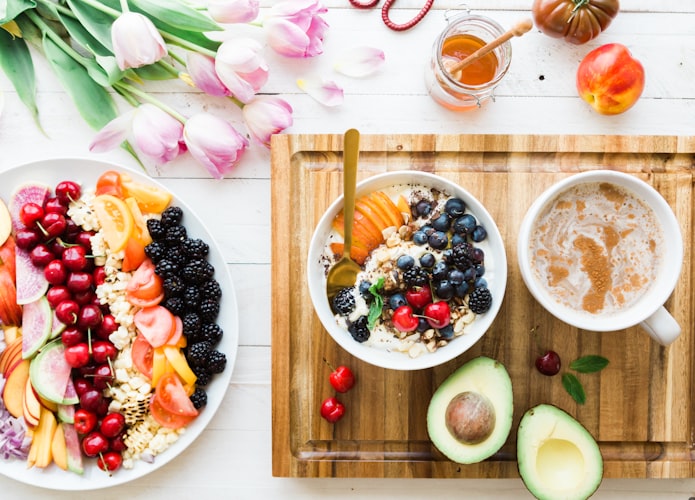
If you think dieting is about tiny meals that leave you feeling hungry
half an hour after eating, we have the perfect plan for you. The
feel-full-all-day diet is designed to show you how to lose weight fast,
but safely- and without ever feeling hungry.
How to lose weight fast – and safely
Our new plan will help you lose at least 3kg in a month – and keep it
off, because it will change any bad eating habits. The plan is healthy
and balanced, it will provide all the vitamins and minerals you need,
and at least five fruit and veg a day – but the best bit is, it has also
been designed to help you feel fuller for longer and keep those
annoying hunger pangs at bay!

How does it work?
It’s based on a concept called the Satiety Index (SI), which was
first introduced by a nutritionist called Dr Susanna Holt from the
University of Sydney. “Satiety” is the technical term used to describe
the feeling of fullness that we get after eating – and some foods are
better than others at producing this feeling. Even after you’ve lost all
the weight you want, you can still follow the basic principles of the
plan, which will help to ensure that the weight doesn’t creep back on
again.
You’re allowed about 5 400 to 5 800 kilojoules a day, which should work out roughly to:
- Between 840 and 1 050 kilojoules for breakfast.
- Around 1 260 to 1 460 kilojoules for lunch.
- 1 900 to 2 100 kilojoules for your traditionally bigger evening meal.
- Plus a 420-kilojoule snack mid-morning and another mid-afternoon.
What makes this diet different is the balance of carbohydrate,
protein and fat in the meals. It isn’t a low-carb diet, but we’ve
slightly reduced the proportion of carbs and focused on low-GI,
slow-release carbs. The plan has more protein than traditional diets
and, rather than low fat, has around 30% fat – but with a focus on
healthy fats.
We’ve given you a week’s worth of meal suggestions so you can get an
idea of what it looks (and tastes) like. After that, you can continue
with our plan, or do your own thing based on this guide.
Don’t worry if you can’t find a meal or snack that fits exactly, just try and keep roughly to these limits.
Breakfasts
Try these fresh ideas for long-lasting energy
- Blackberry smoothie made from 80g fresh or frozen blackberries, 225ml skim milk and 20g porridge oats (rolled oats).
- 150ml fat-free Bulgarian yoghurt with 80g raspberries and 20g oats.
- 1 medium egg, poached, on 1 slice wholewheat bread, and 1 apple.
- Skinny latte and a Woolworths Slimmer’s Choice Mixed Berry Breakfast Bar.
- Fruit salad made from 1 kiwi fruit and 1 plum, topped with 2 Tbsp
fat-free Bulgarian yoghurt, plus 2 oatcakes (we like Nairn’s), each
topped with 1 level tsp peanut butter.
- Mushroom omelette made from 1 medium egg with handful of mushrooms and 1 tomato sautéed in 1tsp oil.
- On the go? Grab a sachet of plain instant oats and 1 small banana.
Lunches
Filling combos to help keep you going
- Bowl of lentil soup (around 840 kilojoules per serving); 100ml low-fat plain yoghurt and a handful of fresh raspberries.
- 1 multigrain wrap, filled with 100g canned tuna in water mixed with
30g sweetcorn, 1 tsp diced red pepper and 1 Tbsp light mayo, plus 1
medium orange.
- 100g skinless roast chicken, 70g canned lentils mixed with 1 Tbsp
fat-free French dressing, handful of sliced cherry tomatoes and 1 Tbsp
diced red pepper.
- Omelette made from 2 eggs with handful of mushrooms and spring onions sautéed in 1tsp oil.
- Half can baked beans (200g) mixed with large handful of cherry
tomatoes served on 1 slice rye bread, plus 150g ready-prepared mango
slices.
Foods to help you feel fuller for longer
- Low-fat/lean proteins, like lean fish and meat.
- Low-fat dairy products, like skim milk and low-fat yoghurt.
- Foods that have a low energy density and large bulk, such as fruit and vegetables.
- Foods that you have to chew, such as corn on the cob and apples.
- Low-GI and fibre-rich carbs, such as beans and pulses.
Adding spices such as curry, ginger and chilli to dishes can help you
feel full quicker and eat less, as they stimulate your taste buds,
causing them to feel satisfied.
The science of snacking
Leaving too long a period between meals is a mistake some people make
when dieting. To keep blood-sugar levels stable and hunger pangs at
bay, you must eat every two to three hours during the day – that means
small meals and a couple of healthy snacks in-between.
Snacks should provide around 420 kilojoules. In terms of balancing
blood sugar and keeping hunger at bay, there’s a big difference between
the 420 kilojoules that come in a chocolate-chip cookie and the 420
kilojoules that you get in a tub of low-fat yoghurt.
Choose fats that provide protein, slow-release carbs and fibre – not just kilojoules. Each snack below is around 420 kilojoules.
- 1 small banana (100g) = 400kJ
- 1 apple (150g) = 290kJ
- 200ml skim milk = 385kJ
- 175ml skim milk and 1tsp cocoa powder = 365kJ
- 150g fat-free Bulgarian yoghurt = 290kJ
- 1 Nairn’s oatcake (190kJ) spread with 20g Philadelphia Light cheese = 420kJ
- Kellogg’s Special K Cereal Bar = 330kJ
- 15g salted microwave popcorn = 335kJ
- 2 bread sticks (175kJ) and 2 Tbsp (30g) reduced-fat hummus = 420kJ
- 2 Ryvita (270kJ) topped with tomato salsa = 420kJ
- 50g (7) ready-to-eat dried apricots = 380kJ
- 40g dates = 430kJ
- 120g low-fat fruit yoghurt = 420kJ
Source:

Коментари
Постави коментар